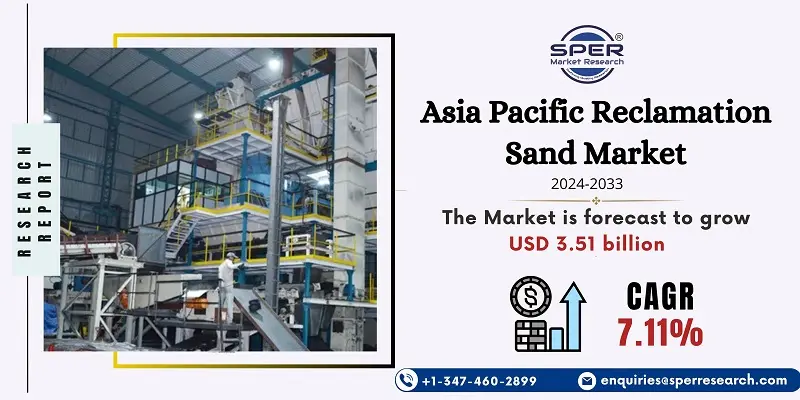
Asia Pacific Reclamation Sand Market Growth, Size, Trends, Demand, Share and Future Outlook
Asia Pacific Reclamation Sand Market Size- By Process, By Application- Regional Outlook, Competitive Strategies and Segment Forecast to 2033
| Published: May-2024 | Report ID: COAM2420 | Pages: 1 - 153 | Formats*: |
| Category : Construction & Manufacturing | |||
- February 2024; A novel thermal reclamation technology was unveiled by Iluka Resources. This invention lowers expenses and lessens the environmental effect of recycling sand. By providing a more environmentally friendly option for the industrial and construction sectors, the new technology is anticipated to strengthen the company's position in the reclamation sand market.
- March 2024; Mangalore Minerals announced a major investment in March 2024 to increase the company's capacity for processing reclamation sand. This expansion intends to support numerous infrastructure projects throughout the region and satisfy the rising demand for sustainable building materials.

Market Opportunities and Challenges

| Report Metric | Details |
| Market size available for years | 2020-2033 |
| Base year considered | 2023 |
| Forecast period | 2024-2033 |
| Segments covered | By Process, By Application |
| Regions covered | China, India, Japan, Thailand, Singapore, Malaysia, Rest of Asia-Pacific. |
| Companies Covered | Asahi Modi Corporation, ASAHI YUKIZAI CORPORATION, Mangalore Minerals Pvt Ltd., Mangal Minerals, TOCHU Corporation, CQMS Razer Pty Ltd, Iluka Resources Ltd., Others |
- Construction Companies
- Foundries
- Automotive Manufactures
- Infrastructure Development Firms
- Government Agencies
- Sand Reclamation Equipment Manufactures
| By Process: |
|
| By Application: |
|
| By Region: |
|
- Asia Pacific Reclamation Sand Market Size (FY’2024-FY’2033)
- Overview of Asia Pacific Reclamation Sand Market
- Segmentation of Asia Pacific Reclamation Sand Market By Process (Wet Reclamation, Mechanical Reclamation, Thermal Reclamation)
- Segmentation of Asia Pacific Reclamation Sand Market By Application (Foundry, Construction)
- Statistical Snap of Asia Pacific Reclamation Sand Market
- Expansion Analysis of Asia Pacific Reclamation Sand Market
- Problems and Obstacles in Asia Pacific Reclamation Sand Market
- Competitive Landscape in the Asia Pacific Reclamation Sand Market
- Impact of COVID-19 and Demonetization on Asia Pacific Reclamation Sand Market
- Details on Current Investment in Asia Pacific Reclamation Sand Market
- Competitive Analysis of Asia Pacific Reclamation Sand Market
- Prominent Players in the Asia Pacific Reclamation Sand Market
- SWOT Analysis of Asia Pacific Reclamation Sand Market
- Asia Pacific Reclamation Sand Market Future Outlook and Projections (FY’2024-FY’2033)
- Recommendations from Analyst
1.1. Scope of the report1.2. Market segment analysis
2.1. Research data source2.1.1. Secondary Data2.1.2. Primary Data2.1.3. SPER’s internal database2.1.4. Premium insight from KOL’s2.2. Market size estimation2.2.1. Top-down and Bottom-up approach2.3. Data triangulation
4.1. Driver, Restraint, Opportunity and Challenges analysis4.1.1. Drivers4.1.2. Restraints4.1.3. Opportunities4.1.4. Challenges4.2. COVID-19 Impacts of the Asia Pacific Reclamation Sand Market.
5.1. SWOT Analysis5.1.1. Strengths5.1.2. Weaknesses5.1.3. Opportunities5.1.4. Threats5.2. PESTEL Analysis5.2.1. Political Landscape5.2.2. Economic Landscape5.2.3. Social Landscape5.2.4. Technological Landscape5.2.5. Environmental Landscape5.2.6. Legal Landscape5.3. PORTER’s Five Forces5.3.1. Bargaining power of suppliers5.3.2. Bargaining power of buyers5.3.3. Threat of Substitute5.3.4. Threat of new entrant5.3.5. Competitive rivalry5.4. Heat Map Analysis
6.1. Asia Pacific Reclamation Sand Market Manufacturing Base Distribution, Sales Area, Product Type6.2. Mergers & Acquisitions, Partnerships, Product Launch, and Collaboration in Asia Pacific Reclamation Sand Market
7.1. Asia Pacific Reclamation Sand Market Size, Share and Forecast, By Process, 2020-20267.2. Asia Pacific Reclamation Sand Market Size, Share and Forecast, By Process, 2027-20337.3. Wet Reclamation7.4. Mechanical Reclamation7.5. Thermal Reclamation
8.1. Asia Pacific Reclamation Sand Market Size, Share and Forecast, By Application, 2020-20268.2. Asia Pacific Reclamation Sand Market Size, Share and Forecast, By Application, 2027-20338.3. Foundry8.4. Construction
9.1. Asia Pacific Reclamation Sand Market Size and Market Share
10.1. Asia Pacific Reclamation Sand Market Size and Market Share By Region (2020-2026)10.2. Asia Pacific Reclamation Sand Market Size and Market Share By Region (2027-2033)10.3. Asia-Pacific10.4. China10.5. India10.6. Japan10.7. Thailand10.8. Singapore10.9. Malaysia10.10. Rest of Asia-Pacific
11.1. Asahi Modi Corporation11.1.1. Company details11.1.2. Financial outlook11.1.3. Product summary11.1.4. Recent developments11.2. ASAHI YUKIZAI CORPORATION11.2.1. Company details11.2.2. Financial outlook11.2.3. Product summary11.2.4. Recent developments11.3. Mangalore Minerals Pvt Ltd.,11.3.1. Company details11.3.2. Financial outlook11.3.3. Product summary11.3.4. Recent developments11.4. Mangal Minerals11.4.1. Company details11.4.2. Financial outlook11.4.3. Product summary11.4.4. Recent developments11.5. TOCHU Corporation11.5.1. Company details11.5.2. Financial outlook11.5.3. Product summary11.5.4. Recent developments11.6. CQMS Razer Pty Ltd11.6.1. Company details11.6.2. Financial outlook11.6.3. Product summary11.6.4. Recent developments11.7. Iluka Resources Ltd11.7.1. Company details11.7.2. Financial outlook11.7.3. Product summary11.7.4. Recent developments11.8. Others
SPER Market Research’s methodology uses great emphasis on primary research to ensure that the market intelligence insights are up to date, reliable and accurate. Primary interviews are done with players involved in each phase of a supply chain to analyze the market forecasting. The secondary research method is used to help you fully understand how the future markets and the spending patterns look likes.
The report is based on in-depth qualitative and quantitative analysis of the Product Market. The quantitative analysis involves the application of various projection and sampling techniques. The qualitative analysis involves primary interviews, surveys, and vendor briefings. The data gathered as a result of these processes are validated through experts opinion. Our research methodology entails an ideal mixture of primary and secondary initiatives.



Frequently Asked Questions About This Report
PLACE AN ORDER
Year End Discount
Sample Report
Pre-Purchase Inquiry
NEED CUSTOMIZATION?
Request CustomizationCALL OR EMAIL US
100% Secure Payment






Related Reports
Our Global Clients
Our data-driven insights have influenced the strategy of 200+ reputed companies across the globe.




















